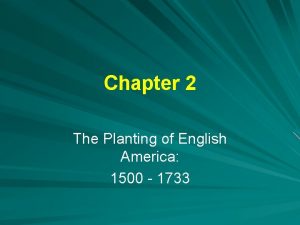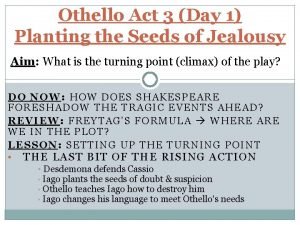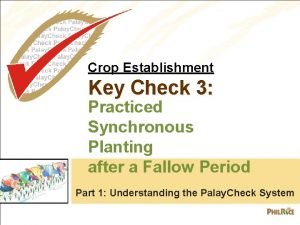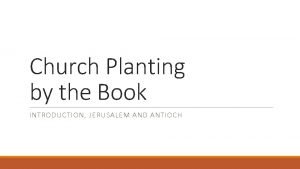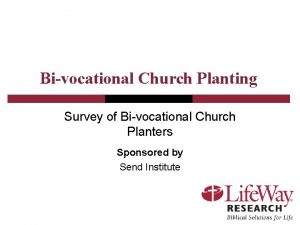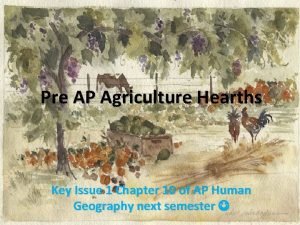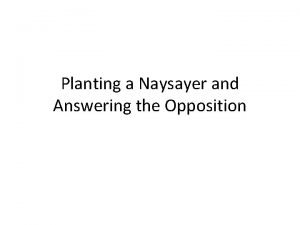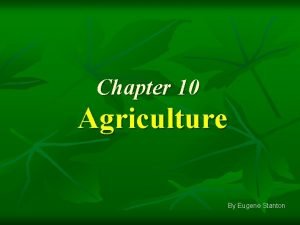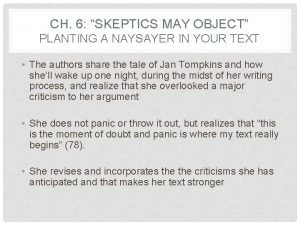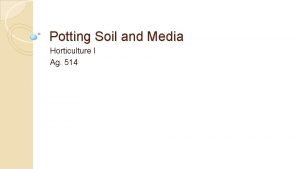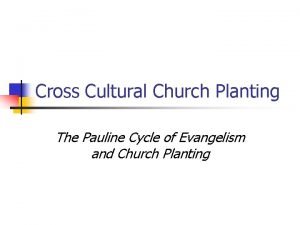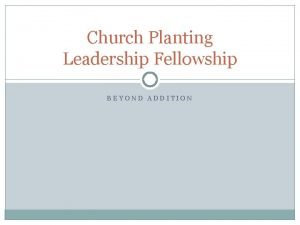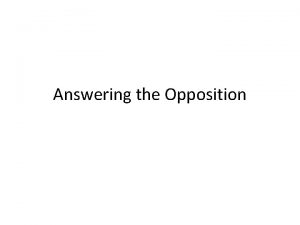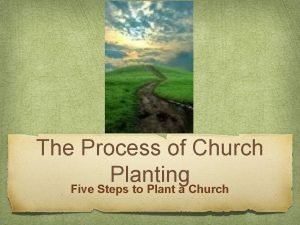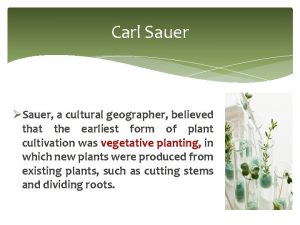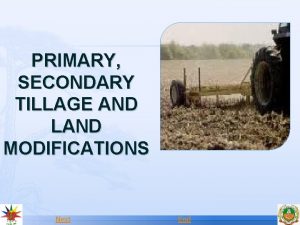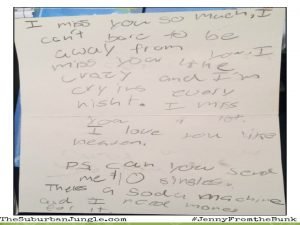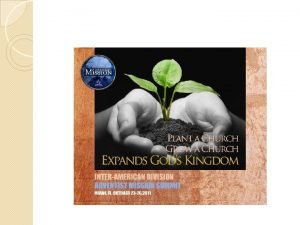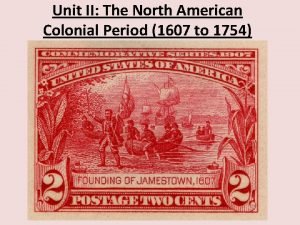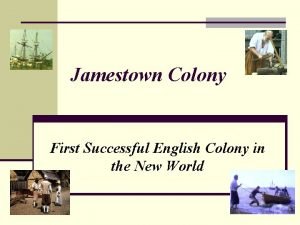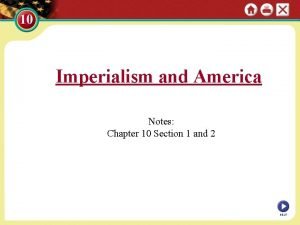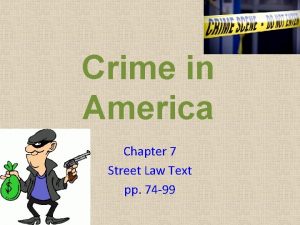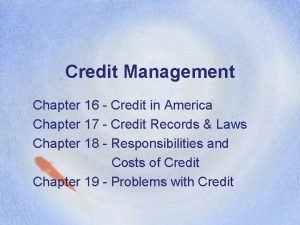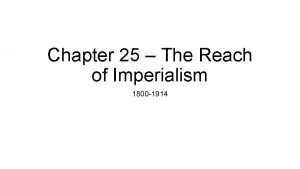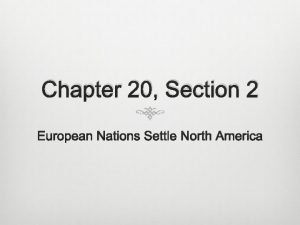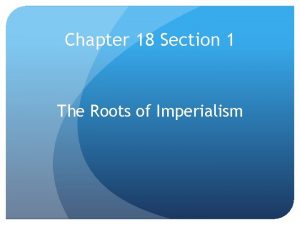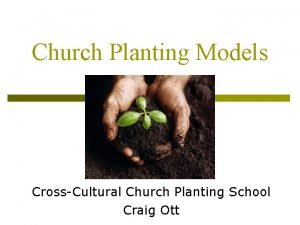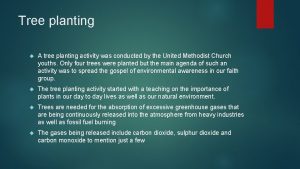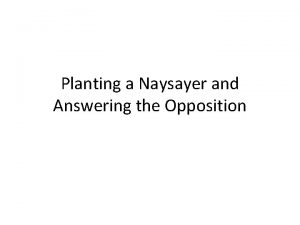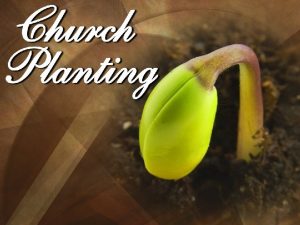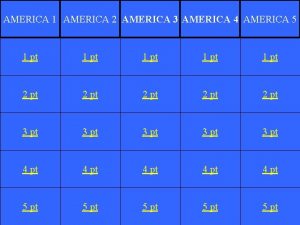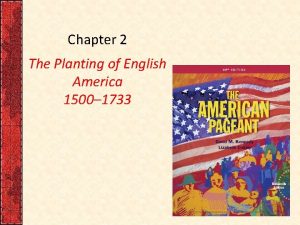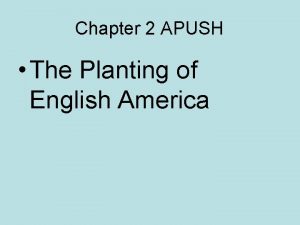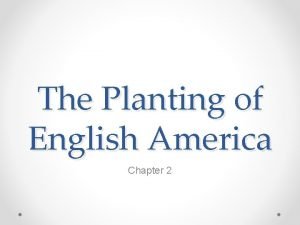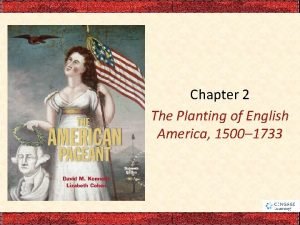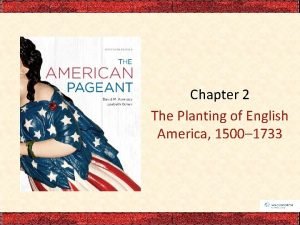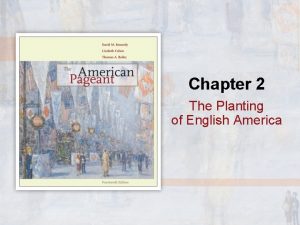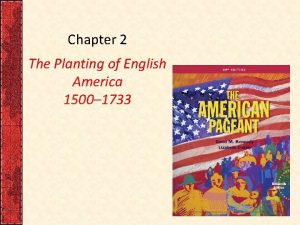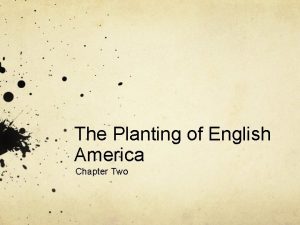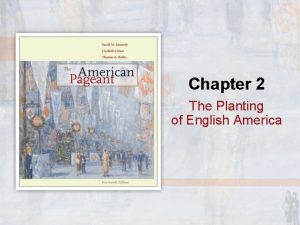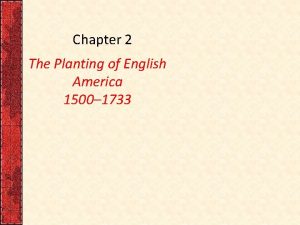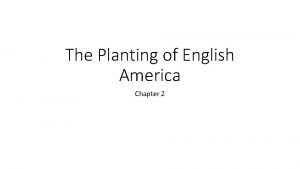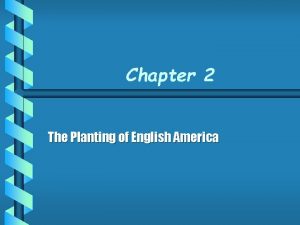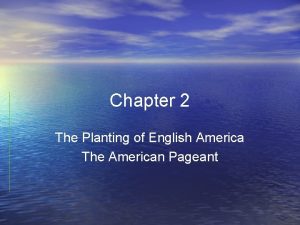Chapter 2 Planting of English America English Policy












































- Slides: 44

Chapter 2 Planting of English America

English Policy • Unlike the Spanish, the English settled in areas without large native empires that could be controlled as workforce. • The English came as families rather than as single young men, so marriage with the Native Americans was less common. • The English and the American Indians coexisted, traded and shared ideas. • Native Americans taught the English how to grow crops such as corn and showed them how to hunt. • Peaceful relations soon gave way to conflict and open warfare. • The English had no respect for American Indians cultures which viewed the as primitive or savage.

• North America in 1600 remained largely unexplored and effectively unclaimed by Europeans. • Colonization and conflict in the northern continent, when the three major European powers planted three primitive outposts in three distant corners of the continent within three years of one another. • The Spanish at Santa Fe in 1610, the French at Quebec in 1608, and, the English at Jamestown, Virginia, in 1607.

England’s Empire • In 1500 s England showed no effort to develop overseas colonies nor to compete with the Spanish Empire. Why? • Allies • As the Spain’s ally in the first half of the century, England took little interest in establishing colonies in North America. • Religious conflict would also disrupted in England. • After King Henry VII broke away from the Catholic Church in 1530 launching what? • Protestant Reformation • Catholics battled with Protestant’s for decades.

• In 1558 Henry’s daughter, the Protestant Elizabeth I, became Queen and established Protestantism in England. • Protestantism, became dominant in England rivalry with Catholic Spain intensified. • Ireland, which had been under English rule since the twelfth century, became an early scene of that rivalry. • The Catholic Irish sought help from Catholic Spain to overthrow the new Protestant English queen. • Spanish aid never amounted to much; in the 1570 s and 1580 s, Elizabeth’s troops crushed the Irish uprising. • The English crown confiscated Catholic Irish lands and “planted” them with new Protestant landlords from Scotland England.

• Encouraged by Queen Elizabeth I English buccaneers practiced privateer upon the shipping lanes especially against the Spanish. • The English sought to promote the twin goals of Protestantism and plunder by seizing Spanish treasure ships and raiding Spanish settlements, even though England Spain were technically at peace. • The most famous of the “sea dogs” was Francis Drake. • He plundered his way around the planet, returning in 1580 with his ship heavily filled with Spanish booty. • His venture netted profits of about 4, 600 percent to his financial backers, among whom, in secret, was Queen Elizabeth. • Defying Spanish protest, Queen Elizabeth knighted Drake.

• Newfoundland was the scene of the first English attempt at colonization. • This effort collapsed when Sir Humphrey Gilbert, lost his life at sea in 1583. • Gilbert’s dream to colonize in the Americas would inspire his half-brother Sir Walter Raleigh. • Walter Raleigh persuaded Queen Elizabeth to renew Gilbert’s charter in his name. • Raleigh organized an expedition that first landed in 1585 on North Carolina’s Roanoke Island, off the coast of Virginia. • Impressed with Raleigh’s discovery the queen would knight him. • In honor of the queen Raleigh would name the land Virginiasince Elizabeth was known as “the Virgin Queen”.


Lost Colony • In 1585 Raleigh would send about 100 men to settle on Roanoke. • Yet after a hard winter the unhappy colonist would return to England. • In 1587 Raleigh would try again. • He would send 91 men, 17 women and 9 children to Roanoke. • The governor of the settlement would return to England for supplies. • He told the settlers that if they were not there when he returned the following year, they should leave a cross carved in a tree symbolizing attack by Native Americans or leave the name of a location if they had moved. • When he had returned to look for the settlers, he found the word COAN carved into the tree. • THE LOST COLONY

The Invincible Armada • • • English failures at colonization contrasted embarrassingly with the glories of the Spanish Empire, whose profits were fabulously enriching Spain. Philip II of Spain, self-anointed foe of the Protestant Reformation, used part of his imperial gains to amass an “Invincible Armada” of ships for an invasion of England. 1588 England defeated the “Invincible Armada”—marking the end of the Spanish imperial dreams. The English victory started them to becoming masters of the world oceans—very important to the American people. The defeat for the Spanish marked the beginning of the end to their imperial dream.



England on the Eve of Becoming an Empire • England took on strong economic and social changes, along with a “surplus population. ” Its population was mushrooming from some 3 million in 1550 to 4 million in 1600. • In the English countryside, landlords were “enclosing” croplands for sheep grazing, forcing many small farmers into precarious tenancy or off the land altogether. • This enclosure method would cause the wool industry to go into an economic depression. • The depression would cause thousand of Puritan's to immigrant to America.

• By the early 1600 s, the joint-stock companies, allowed a considerable number of investors called “adventurers” to pool their capital. • Peace with Spain provided the opportunity for English colonization. • Population growth provided the workers. • Unemployment, as well as a thirst for adventure, for markets, and for religious freedom, provided the motives. • All of these reason would allow the joint-stock companies to provided the financial means.

JAMESTOWN • A joint-stock company, known as the Virginia Company of London, received a charter from King James I of England for a settlement in the New World. • On December 20, 1606 the company would send 3 small ships the Susan Constant, Godspeed and Discovery. • The main attraction was the promise of gold, combined with a strong desire to find a passage through America to the Indies. • The Virginia Company’s three ships landed near the Chesapeake Bay where they would be attacked by Native Americans. • They would find what colony? • May 24, 1607 the Virginia colony of Jamestown in honor of King James I was founded.

Jamestown Problems • City people. • Knew nothing about living in the woods and the abundant fish and game around them. • Knew nothing about raising livestock or agricultural. • Upper-class refused to work. • Jamestown’s governing council argued constantly and could not make a decisions. • Lawlessness, sickness, and food shortages all took their toll. • Out of the 200 settlers that arrived in the colony only 53 were alive at the end of the first year.

• John Smith was a member of Jamestown’s governing council he would emerge as the only strong leader. • John Smith-taking over in 1608 he would rule with an iron fist. “He who shall not work shall not eat. ” • He persuaded the Powhatan people to provide food for the colonist of Jamestown. • In 1607 Native Americans had captured him and prepared to kill him. • Who would save John Smith from the Powhatan? • Pocahontas she was only 11 and placed her head between his and the war clubs of his of the Powhatan • The Chief never trusted the English and his daughter interacted with the English.

Horrors of Jamestown • What factors contributed to the near failure of Jamestown? • Disease the unwillingness of many colonist to work the hostile efforts of the Powhatan. . • Had no leadership since John Smith had returned to England. • The winter of 1609 -1610 was horrible became known as “Starving Winter” • Colonist ate rats, snakes, dogs, toadstools, and horsehides. • Some even dug up the graves and ate humans. • One hungry man killed salted and ate his wife for this act he was executed.


Cultural Clashes in the Chesapeake • 1607 Chieftain Powhatan; the James River area. • 1610 Lord Da La Warr arrived from England with orders to deal with the Indians. • 1614 the First Anglo-Powhatan War ended, sealed by Pocahontas’ marriage to colonist John Rolfe—the first known interracial union in Virginia

Cultural clashes in the Chesapeake • 1644 the Second Anglo-Powhatan War, one last attempt by the Indians to dislodge the Virginians. • Powhatans’ misfortune to fall victim to the three Ds: disease, disorganization, and disposability. • The “Powhatan’s Confederacy” lacked unity to oppose the disciplined whites. • The Powhatans Confederacy had no economic function for the Virginia colonists.

The Indians’ New World • Indigenous people’s destinies had changed. • The shock of large-scale European colonization disrupted Native American life. • Some changes, horses, diseases, trade, and the expanding Atlantic economy transformed Indian life. • A new middle ground compelled both Europeans and Native Americans to accommodate each other.

p 30

Virginia: Child of Tobacco • 1612 John Rolfe perfects tobacco culture in Virginia. • Virginia’s prosperity was built on tobacco smoke—“bewitching weed” and King Nicotine. • 1619 A Dutch warship appeared off Jamestown and sold some twenty Africans, planting the seed of North American slavery. • 1619 Representative self-government was born in primitive Virginia.

Virginia: Child of Tobacco • 1619 Representative self-government was born in primitive Virginia. • The House of Burgesses, an assembly or miniature parliament in the New World. • James I grew increasingly hostile to Virginia. • 1624 He revoked their charter and Virginia became a royal colony.


Maryland: Catholic Haven • 1634 Maryland, the second plantation colony, was founded by Lord Baltimore. • It was partly created as a refuge for Catholics. • Resentment flared into open rebellion between Catholics and Protestants resulting in the Baltimore family for a time losing its proprietary rights.

Maryland: Catholic Haven • Lord Baltimore permitted unusual freedom of worship at the outset. • 1649 The local assembly passed the famed Act of Toleration guaranteeing toleration to all Christians. However, it decreed the death penalty for Jews and atheists, who denied the divinity of Jesus.

The West Indies: Way Station to Mainland America • 1655 England secured claims to several West Indian islands, including Jamaica. • Sugar formed the foundation of the West Indian economy. • Sugar was to the Caribbean as tobacco was to the Chesapeake Bay area- one difference tobacco was a poor man’s crop. • Importing of enslaved Africans to work the sugar plantations.

The West Indies: Way Station to Mainland America • 1661 Barbados slave code defined the slaves’ legal status and their masters’ complete control over their laborers. • Profitable sugar-plantation system crowded out almost all other forms of Caribbean agriculture. • 1670 Arrival in the Carolinas of displaced English settlers from Barbados, with the slave code.

p 33


Colonizing the Carolinas • 1640 s Civil War broke out in England when Charles I dismissed the Parliament. • 1660 Charles II would be restored to the throne after the beheading of the Puritan leader Oliver Cromwell. • 1670 Carolina, named for Charles II, was formally created. • Rice emerged as the principle export crop of South Carolina. • Charles Town became the busiest seaport in the South. • 1700 Carolina was too strong to be wiped out. By all the Native America uprising which had been incited by the Spanish.


The Emergence of North Carolina • “The Squatters” newcomers without legal rights to the soil, raised crops with slaves. • Distinctive traits developed rapidly in north Carolina. • 1712 North Carolina officially separated from South Carolina

The Emergence of North Carolina • North Carolina shared with tiny Rhode Island several distinctions: – Most democratic – Most independent-minded – Least aristocratic of the original thirteen English colonies

The Emergence of North Carolina Bloody relations between Indians and Europeans: • 1711 -1713 Tuscarora War • Tuscaroras became the Sixth Nation of the Iroquois Confederacy • 1712 North Carolina formally separated from South Carolina. • 1715 -1716 Yamasee War in South Carolina



p 36

p 37

Late-Coming Georgia: The Buffer Colony • 1733 Georgia colony founded as a buffer. Why was it called a buffer? • Protected the more valuable Carolinas from the Spaniards in Florida and against the hostile French from Louisiana. • It was named in honor of King George II of England. • Launched by a high-minded group of philanthropists as a haven for wretched souls imprisoned for debt. • Georgia was determined to keep slavery out. • Founder: James Oglethorpe.

Late-Coming Georgia: The Buffer Colony • Georgia was called “the Charity Colony” • Savannah like Charleston was a melting-pot community. • All Christian worshipers except Catholics enjoyed religious toleration. • John Wesley served as a missionary.

The Plantation Colonies England’s southern mainland colonies shared: • Devotion to exporting agricultural products, mainly tobacco and rice; • Slavery; • Growth of cities; • Religious toleration; • All were in some degree expansionary.
 The planting of english america
The planting of english america We can do a rap of the map of the us
We can do a rap of the map of the us Asia europe south america
Asia europe south america Whats an onomatopeia
Whats an onomatopeia Why called latin america
Why called latin america Happening e performance
Happening e performance How does iago plant the seed of jealousy in othello?
How does iago plant the seed of jealousy in othello? Iago planting seeds of doubt quote
Iago planting seeds of doubt quote Synchronous planting is an example of
Synchronous planting is an example of Introduction to church planting
Introduction to church planting Bivocational church planting
Bivocational church planting Objectives of planting flowers
Objectives of planting flowers Swath definition
Swath definition Crop hearths map
Crop hearths map Naysayer paragraph
Naysayer paragraph Nets church planting
Nets church planting Vegetative planting probably originated in
Vegetative planting probably originated in What is a naysayer in writing
What is a naysayer in writing Carbonate salts examples
Carbonate salts examples Pauline cycle
Pauline cycle Church planting leadership fellowship
Church planting leadership fellowship Planting a naysayer in your text
Planting a naysayer in your text Steps to planting a church
Steps to planting a church Carl sauer vegetative hearth theory
Carl sauer vegetative hearth theory Planting more trees
Planting more trees Tree planting
Tree planting Crop planting
Crop planting Different types of tillage
Different types of tillage Essay on benefits of planting trees
Essay on benefits of planting trees Othello's jealousy
Othello's jealousy Planting zones arizona
Planting zones arizona Nexus church planting
Nexus church planting Seedsense cap
Seedsense cap Precision planting graphite powder
Precision planting graphite powder English settlements in america
English settlements in america First successful english colony
First successful english colony First successful english colony
First successful english colony Chapter 10 section 2 central america and the caribbean
Chapter 10 section 2 central america and the caribbean Imperialism and america chapter 10 section 1
Imperialism and america chapter 10 section 1 Street law chapter 7
Street law chapter 7 Property pledged to assure repayment of a loan
Property pledged to assure repayment of a loan Chapter 25 lesson 2 empire building in africa
Chapter 25 lesson 2 empire building in africa European nations settle north america
European nations settle north america Chapter 19 section 3 popular culture
Chapter 19 section 3 popular culture Roots of imperialism
Roots of imperialism
